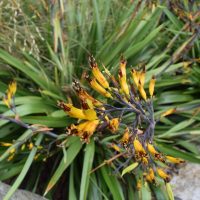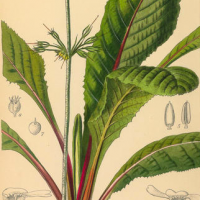July Color Appears at the Washington Park Arboretum
1) Colutea orientalis Bladder Senna
This deciduous native of northern Iran has delicate bluish-green pinnate leaves.
The orange flowers are followed by surprising translucent bladder-like fruit pods.
You can find Colutea orientalis in the Legume Collection along Arboretum Drive.
2) Hydrangea macrophylla ‘Mme. Emile Mouillere’ Bigleaf Hydrangea
Hydrangea macrophylla is native to Japan.
This cultivar is an example of the Hortensia group – having mophead flowers.
Summer Arrives at the Washington Park Arboretum
1) Cunninghamia lanceolata (Chinese Fir)
Bluish evergreen foliage contrasts nicely with its scaly bark.
This evergreen tree from China is an important timber tree in its native area.
In 1701, James Cunningham (one of the first European plant hunters to visit China) described and collected this tree.
2) Hydrangea integrifolia (Evergreen Climbing Hydrangea)
A vigorous, evergreen vine climbing to over 40 feet, on the trunk of a mature Douglas Fir.
Read moreGlimpse into the past – Arboretum Club House
by John A. Wott, Director Emeritus
In the early days of the Washington Park Arboretum, the Arboretum Club House and Floral Hall exhibit space was the venue for many flower shows, exhibits and functions. It was the only facility where public functions could be held in the Arboretum.
On April 7, 1968, a fire was discovered at 7:00 a.m. in the Club House.
The Wonderful World of Monocots
Monocotyledons, commonly referred to as monocots, are flowering plants whose seeds typically contain only one embryonic leaf, or cotyledon. A quarter of the world’s known plants are monocots. They are the most economically important group of plants to humans today in agriculture, horticulture, forestry and fiber industries. Here are a few samples of monocots in our plant collections.
1) Allium schubertii (Ornamental Tumbleweed Onion)
Dried seed heads look like starry tumbleweeds or shooting star fireworks
Located in the Soest Herbaceous Display Garden, bed 6 at the Center for Urban Horticulture
2) Austroderia richardii syn Cortedaria r.
Read moreGlimpse into the past – Changes in the Landscape
by John A. Wott, Director Emeritus
Currently there are many physical changes occurring in the north end of the Washington Park Arboretum, due to the construction of new SR-520 bridge. Local residents often remark that these changes will “disfigure” the natural landscape which has always been there. The truth is, this area has been greatly changed and altered over the past one hundred years, ever since the level of Lake Washington was lowered.
Spring Pushes Forth at the Washington Park Arboretum
1) Ostrya carpinifolia Hop Hornbeam
This small-to-medium-sized tree (40-50’) is native to southern Europe and southwestern Asia.
The common name refers to the fruit which resembles the fruit of Humulus (Hops).
Ostrya is from Greek, meaning “bone-like” in reference to the trees dense hard wood.
Located north of East Foster Island Road, east of the Broadmoor entrance.
2) Picea mariana ‘Doumetii’ Doumet Black Spruce
This selection of Picea mariana is a popular slow-growing shrub with blue green needles and a dense conical growth habit.
Read moreMay Colors Appear Just in Time for Mother’s Day!
Happy Mother’s Day!
1) Philadelphus coronarius
Native to southeastern Europe and Asia Minor, this shrub is located within the Sorbus Collection. It is perhaps the best-known species of mock orange in gardens because of its sweet smell. The fragrance of its flowers is pleasing out-of-doors, but may become too strong if the plants are numerous or near sitting room windows.
Philadelphus is a member of the plant family, Hydrangeaceae.

